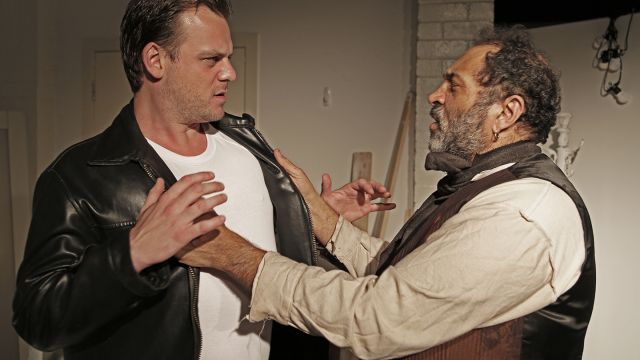The Caretaker
Throwing Shade Theatre’s production of The Caretaker, directed by Courtney Powell, is true to Pinter’s portrayal of three damaged and deluded souls that come together, each cast member bringing their own persona to the script, and life to Pinter's lively dialogue.
Never a dull moment, and fast paced, the characterisation was excellent.
The actors’ performances contrast effectively. Davies (Nicholas Papademetriou) is a dishevelled, witty, crafty homeless man, with attitudes of long lost grandeur, finicky with his appearance and shoes. Aston (Andrew Langcake) is a gentle victim of ECT therapy, obsessed with electric plugs, his characterisation as a damaged victim, exhibited in his slow and numbed seemly emotionless responses to Davies. Aston’s brother Mick (Alex Bryant-Smith) is a gregarious ‘bouncer-like’ creature, full of dreams, aggression and sudden outbursts of violence in contrast to his kind gentle brother.
Davies, a homeless man is invited to stay the night by Aston, at Aston’s brother’s house.
Aston disappears often in the night, with Mick turning up. Both offer Davies the ‘caretaker position’. Whilst Davies is contemplating the offer, he becomes a man of secrets which he is uneasy to expose. He has two identities, one of Jenkins, an assumed identity, the other of Davies, apparently his real identity, but who knows if he is telling the truth.

All the cast are excellent in their characterisation, with accents spot on. All exhibit a vulnerability in their roles. Papademetriou, as Davies, plays his character as a lively man, with a hint of un-trustworthiness, covering up his lies as quickly as he tells them, very wary and protective of his identities, amusing in his rhetoric about various shoes, reminiscent of a conman, similar to the ‘Artful Dodger’. Langcake, as Aston, is memorable in his speech as an unwilling victim of ECT, with a loss of emotion due to being institutionalised, suggested in his surroundings. He’s slow, quiet, in his own world. Bryant-Smith as Mick, is intimidating as a walking time bomb of emotions.
The set (designed by Natalie Hughes) was a cluttered room, full of papers, rubbish, two hospital type beds, an old gas stove, a room with a broken window overlooking a yard, a large silver bucket hanging from the ceiling. All the set and props were white, the beds and blankets gave the setting an institutionalised feel such as that in a Psychiatric hospital that Aston experienced. This setting suited the intimate space of the theatre. A great script that was done justice by the cast and crew.
Charlotte Hanson
Subscribe to our E-Newsletter, buy our latest print edition or find a Performing Arts book at Book Nook.

